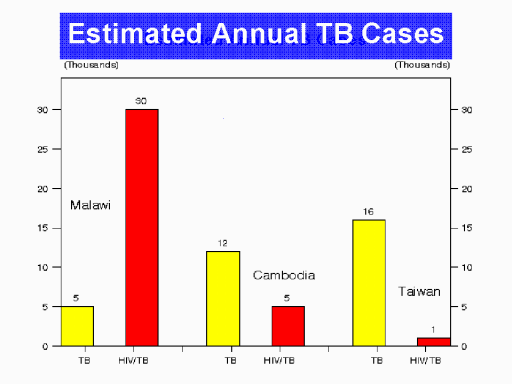| front |1 |2 |3 |4 |5 |6 |7 |8 |9 |10 |11 |12 |13 |14 |15 |16 |17 |18 |19 |20 |21 |22 |23 |24 |25 |26 |27 |28 |29 |30 |31 |32 |33 |review |
 |
The
Parallel Epidemics of AIDS and Tuberculosis
Potential interactions between HIV and other infectious disease
agents have caused great medical and public health concern.
The major interaction identified is with Mycobacterium
tuberculosis (Mtbc), the etiologic agent or cause of
pulmonary tuberculosis (TB). Persons with latent Mtbc
infection and who are also infected with HIV develop clinical
tuberculosis (TB) at an increased rate.
Clinical studies have shown that dually infected persons
develop clinical TB (pulmonary or disseminated) when their CD4 cell
counts are moderately depressed (about 350/mm3).
This contrasts with Pneumocystis jiroveci pneumonia (PCP) that usually occurs in HIV-infected persons with less than 200 CD4/mm3. In populations where the prevalence of infection with Mtbc and HIV are both very high, such as in sub-Saharan Africa, huge increases in the annual number of TB cases related to HIV infection can be expected. In Malawi, where there is a high prevalence of both Mtbc and HIV, annual HIV related TB cases will be several times the annual number of TB cases who are HIV negative. In Cambodia, where there is a high Mtbc prevalence and a relatively high HIV prevalence, annual HIV related TB cases will be about half of the annual TB cases without HIV and in Taiwan, where Mtbc infections are moderate and HIV prevalence is low, annual HIV-related TB cases will be less than 10% of the annual TB cases that are HIV negative. |